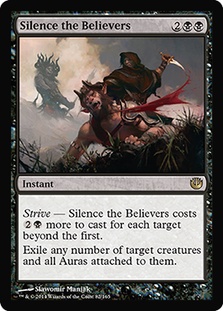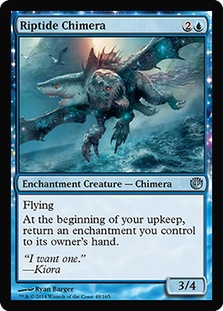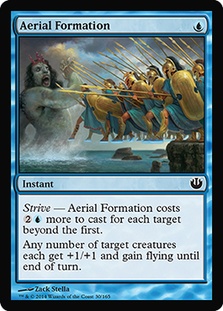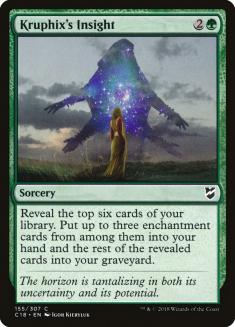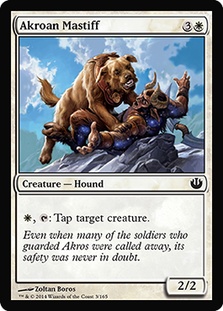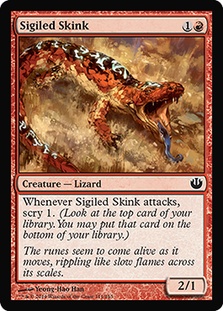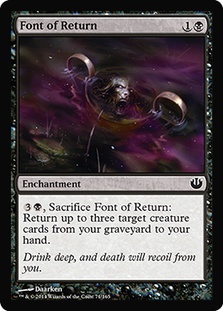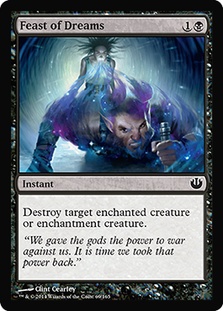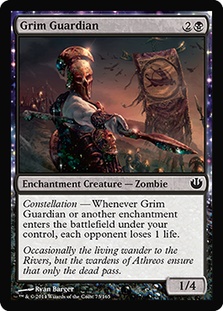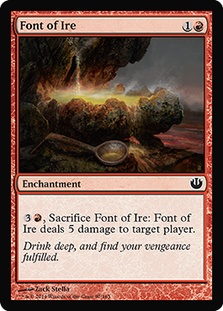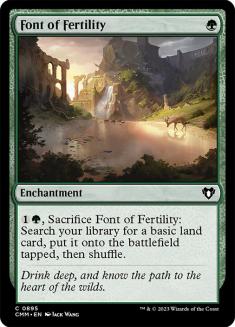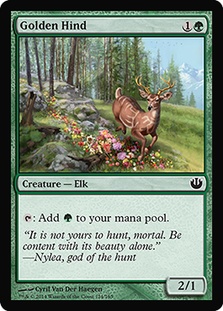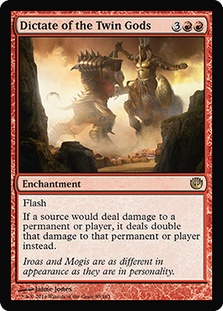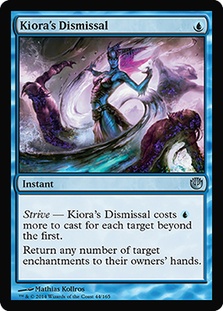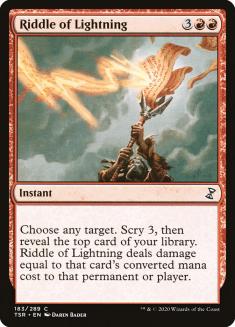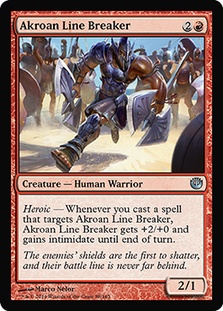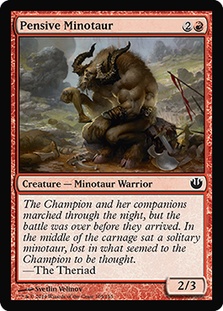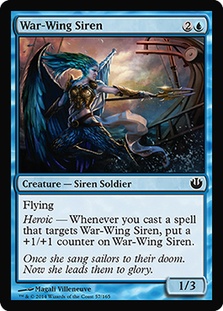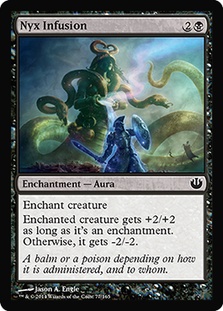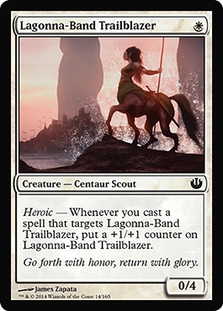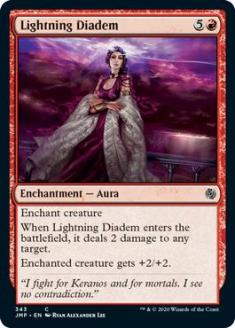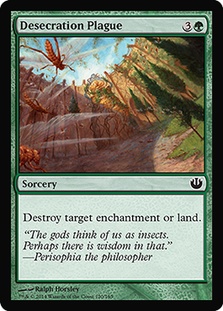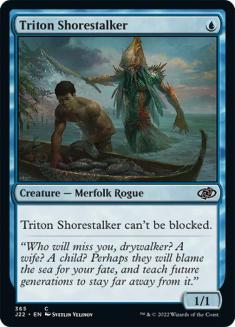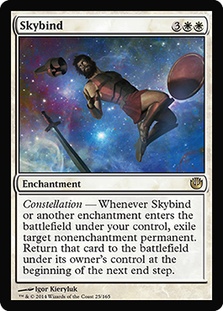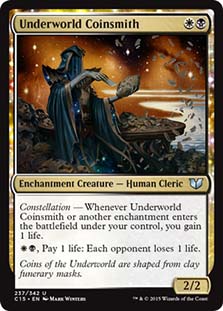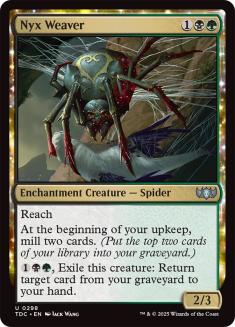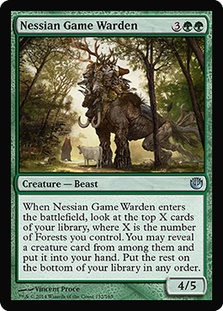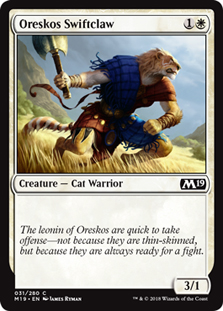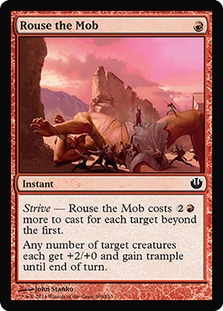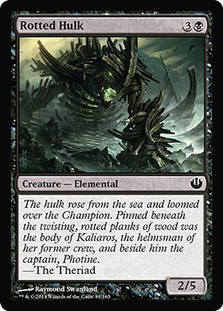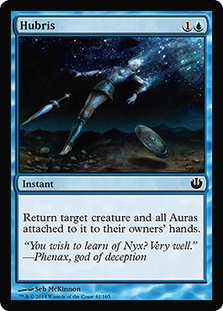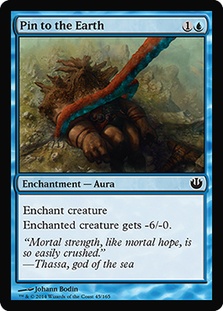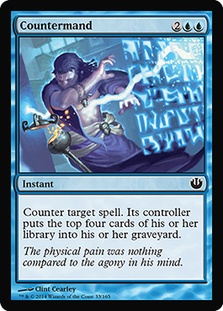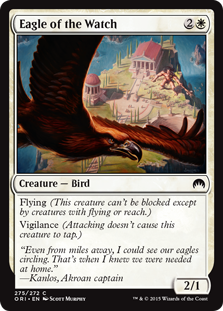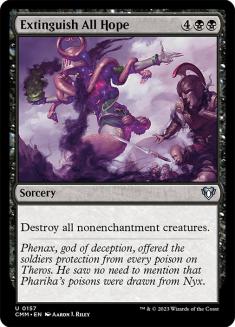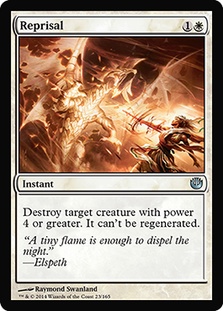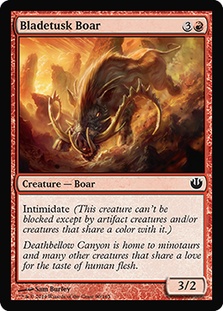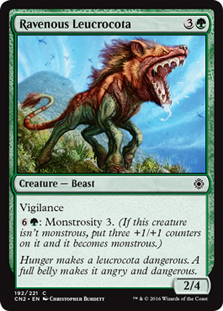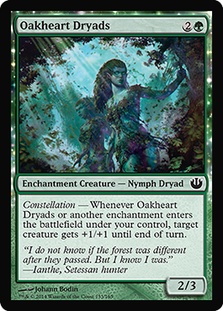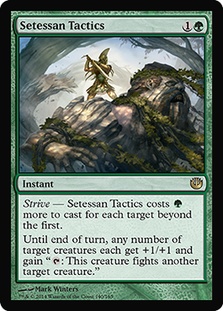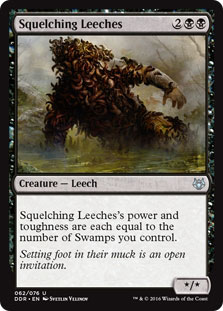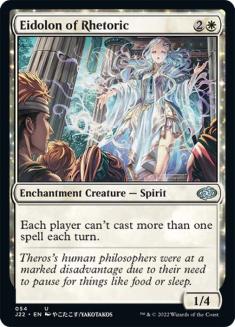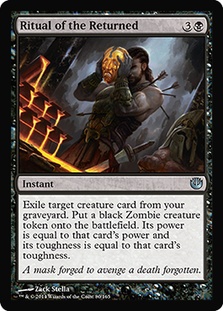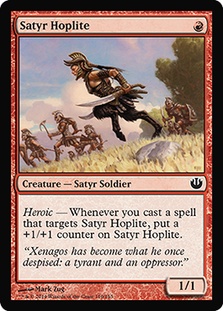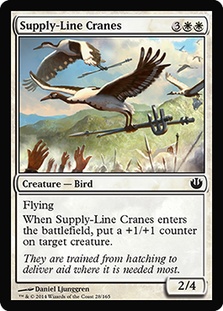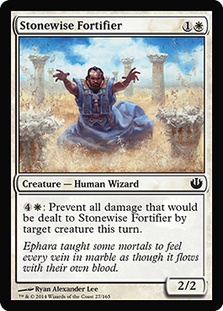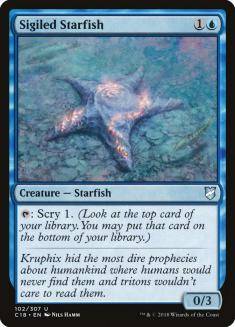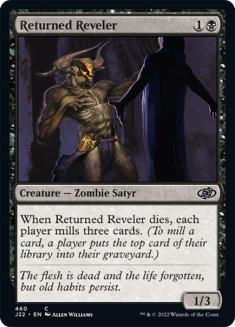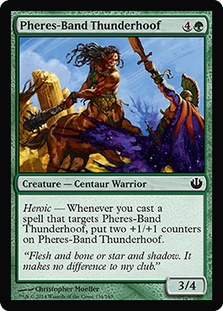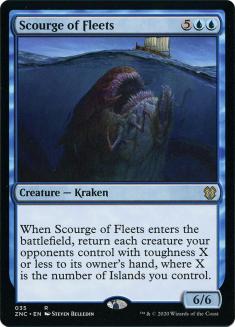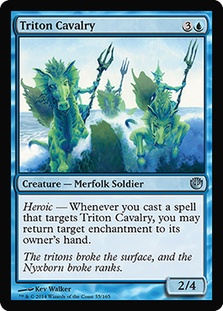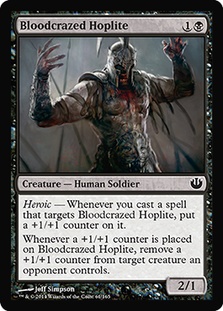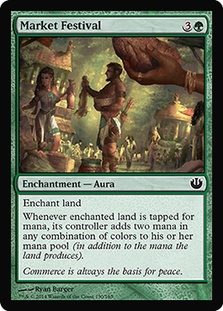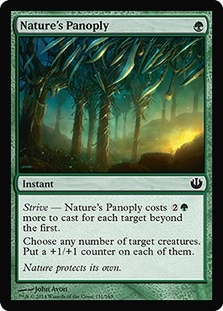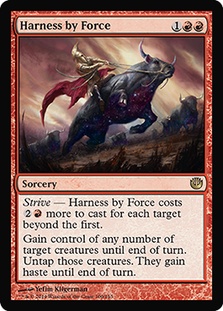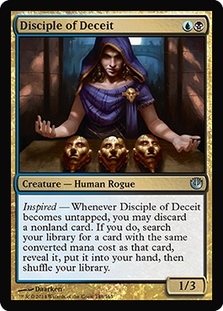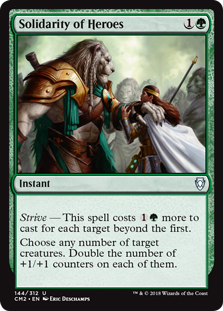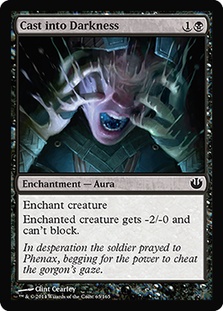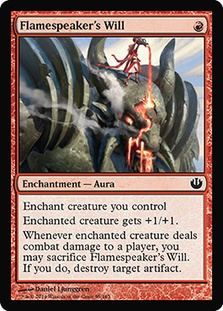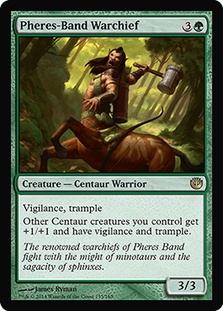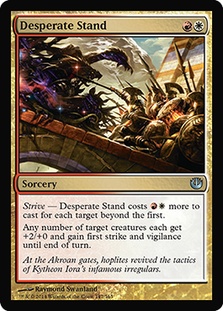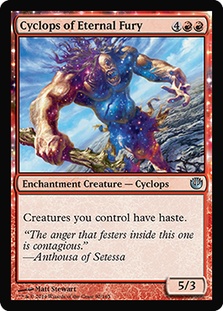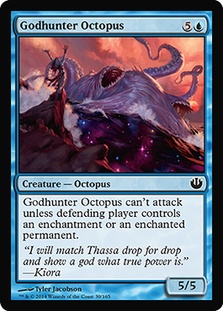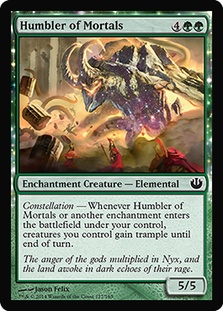With the release of Journey into Nyx, the Theros block Limited format undergoes its second major transition. The fact that the latest set becomes the first pack to be drafted means that old Theros and Born of the Gods pick orders are history, at least with respect to the crucial early decisions. Is there anything we can do in this early stage of the format’s exploration apart from drafting? I think there is—all we need is a bit of imagination!
I’ll admit that it is somewhat difficult to create Limited content between the Prerelease and the Pro Tour. Limited reviews have already been written at this point, but draft videos are not yet an option. And card evaluations are still in flux, meaning that there is no consensus yet to fuel theoretical arguments and discussions.
This article is an experiment. It covers eight packs opened in order around a draft table. It is also an exercise. I want you to figure out the first four picks of each player. Take out a sheet of paper or open up a spreadsheet and write down the cards you think should be picked. I’ll provide you with my thoughts and analysis and a rough list of the most powerful cards in the pack. Feel free to disagree with me, deviate, and post your results and rationale. If you aren’t sure at any point, take out another sheet and see what ramifications the alternative decision would have.
The eight remaining players sit down to draft. They have done it—they have made a PTQ Top 8 playing a brand-new Limited format for the second time since the Prerelease. Journey into Nyx hasn’t been released on Magic Online yet, which means no drafting and no videos to watch. They devoured the early Limited reviews, of course, but the Draft format is mostly unexplored as the Magic world waits for the Pro Tour.
Pack 1
Alice is receiving cards from Harry and passing to Bob.
Not a bad pack to start a draft with. Silence the Believers is not only unconditional instant speed removal, but it breaks the rules of the format by denying bestow creatures their inherent card advantage. Adding in the fact that it will deal with the opponent’s two best threats for seven mana and sometimes win the game on the spot for ten, you have a clear first pick.
Feast of Dreams and Nightmarish End are the second and third best black cards in the pack respectively. While I would not want to overload on Feast of Dreams for danger of not having enough targets, the scariest creatures of the format are enchanted. They also tend to grow quite huge, which makes a removal spell that does not care about a creature’s toughness the superior choice.
Looking at the other colors, red’s uncommon Forgeborn Oread has a built-in card advantage mechanism, but killing one-toughness creatures is not of the utmost importance in Theros block Limited. Green has its best common to offer in Golden Hind. On the other hand, Akroan Mastiff does not come close for white. While in theory tapping down large creatures is something you want to be doing, paying four mana for a 2/2 and holding up a Plains in a color with heavy mana requirements will often cost you more tempo than you can afford.
Blue is difficult to evaluate in this pack. Riptide Chimera and Aerial Formation have potentially high upsides, but both can be underwhelming or in the case of the Chimera downright detrimental. There is an additional problem with Aerial Formation in the sense that there is a real danger of getting flooded with tricks in this format. While Aerial Formation is great if it wins you the game when cast, it’s not a particularly good trick if you’re attacking into your opponent’s blockers.
Taking into account how the Theros block Draft format has played out so far, I think that Forgeborn Oread is worse than Golden Hind and Feast of Dreams. While it might be possible to draft a dedicated constellation deck, pinging is pretty much at its worst in this format. Comparing Golden Hind and Feast of Dreams, we’re looking at some of the best commons of each color. I could see going with either depending on preference, but you actively want to have as many mana accelerants as possible in green (see Voyaging Satyr), whereas you do not want to draft too many Feast of Dreams. This leaves me with the following list.
1. Silence the Believers
2. Golden Hind
3. Feast of Dreams
4. Forgeborn Oreads
Pack 2
Bob is receiving cards from Alice and passing to Charles.
After dismissing Dictate of the Twin God for its symmetry, Riddle of Lightning is the best red card in the pack. While it does not deal with creatures of arbitrary size, the fact that it is an Instant, deals damage to players if needed, and generates virtual card advantage with a triple scry makes it far superior to cards like Rage of Purphoros.
Black and green offer no cards of first-pickable quality, with Nyx Infusion being only just playable. It is worse than mediocre removal spells like Pharika’s Cure while also being one of the worst ways to enhance a creature the format has to offer. White has Lagonna-Band Trailblazer, which is a bit tricky. Heroic cards tend to be best in aggressive decks, but 0/4 base stats are the opposite of that. No evasive capabilities mean that quite a lot of effort is needed to make the Trailblazer worth its slot.
In blue Kiora’s Dismissal is another strive card to evaluate. While it is color intensive, bouncing multiple enchantments can be backbreaking. However, the main reason that bounce is so good in this format is that you can hold up one or two mana to return any creature to your opponent’s hand, something that Kiora’s Dismissal will not do in general. Different from other strive cards, Kiora’s Dismissal also fails at being a heroic enabler. Speaking of heroic, War-Wing Siren is blue’s Wingsteed Rider in this set. Easier to cast and only a bit weaker, I really like the look of the 1/3 heroic flyer.
I could see first picking either Riddle of Lightning or War-Wing Siren out of this pack. Given that you want as many heroic creatures in a heroic deck as possible but only a very limited amount of damage-based removal spells for five mana, I have to say that War-Wing Siren is the better choice.
1. War-Wing Siren
2. Riddle of Lightning
3. Nyx Infusion
Pack 3
Charles is receiving cards from Bob and passing to David.
Underworld Coinsmith and Nyx Weaver are fine cards, but neither offers a crazy power level that warrants first picking a gold card. In Nessian Game Warden and Hubris, green and blue offer very different but powerful cards. Looking at the white cards, Oreskos Swiftclaw narrowly edges out Eagle of the Watch because it is the more efficient package.
How do we decide between a card advantage beast, a three-power two-drop, and a bounce spell? Nessian Game Warden offers the rarest of effects, but green generally has little trouble filling up the higher slots in the curve. On the other hand, Oreskos Swiftclaw is a welcome addition to any white deck. In aggressive ground-based decks like W/R, it is one of the best early attackers. In evasive decks like U/W, it also represents early damage potential but will be even more valuable when trading with the opponent’s more expensive ground creatures on defense.
Last but certainly not least, there is Hubris. Going back to one of the earlier discussions, is this a card you can have too many of? If history is any indication, bounce spells (see Voyage’s End) are at an absolute premium and a must for blue decks to have as a failsafe. If you already have enough bounce spells going into the Theros pack, you aren’t forced to pick Voyage’s End if there are cards that you would rather have at that point like Nimbus Naiad.
1. Hubris
2. Oreskos Swiftclaw
3. Nessian Game Warden
Pack 4
David is receiving cards from Charles and passing to Eve.
Even if you do your best to maximize Extinguish All Hope, you still have no control over the permanents that your opponent brings to the battlefield. Considering that your opponent gets the first shot at rebuilding or bestowing after you have spent your turn casting a symmetric sorcery, this is not a card I advise first picking. That leaves Nightmarish End as the best black card. However, there is quite a lot of competition.
In red Bladetusk Boar is a solid card but not a first pick by any means despite Intimidate. Every other color has two very solid cards to pick from—white has Oreskos Swiftclaw and Reprisal, blue has War-Wing Siren and Hubris, and green has Oakheart Dryads and Ravenous Leucrocota. While I really like the Leucrocota as the smaller and much fairer pendant to Nessian Asp, I don’t think the green cards come close in power level to be considered here.
When it comes to the decision between War-Wing Siren and Hubris, nobody will fault you for picking Hubris every single time. I do however think that the Siren will be better and more important in certain decks than Hubris. That said, the real all-star in this pack is Reprisal. While white decks do not want too many effects that do not trigger heroic, instant speed removal for creatures that have grown out of hand is invaluable. The fact that it downright kills Nessian Asp is a great bonus.
1. Reprisal
2. Hubris
3. War-Wing Siren
4. Oreskos Swiftclaw
5. Nightmarish End
Pack 5
Eve is receiving cards from David and passing to Fred.
Setessan Tactics is a pretty bomby rare that fits into what green is trying to do in this format. It does require a heavy commitment to green and needs some large creatures on the battlefield, but if your green deck is performing as it should, that should not be a problem.
The remainder of the pack has some known quantities in Feast of Dreams and War-Wing Siren and some new additions in Squelching Leeches, Satyr Hoplite, Supply-Line Cranes and Sigiled Starfish. First of all, I cannot see Sigiled Starfish being better than War-Wing Siren. As much as I like to smooth out my draws, casting a 0/3 creature with a slow advantage mechanism in this format is just asking for trouble.
Satyr Hoplite is interesting since it is common hero for one mana. On the other hand, it lacks the evasion of its more expensive counterparts or an ability like that of Favored Hoplite. We also have to keep in mind that the number of Ordeals and cheap bestow creatures is lower now that Journey into Nyx is in the mix, most notably without a common bestow cycle.
Squelching Leeches is not really a consideration when Feast of Dreams is in the pack, but it does offer an interesting decision. At which point do you want to commit to a card that asks you to play ten or more Swamps but offers huge rewards if you end up in mono-black? My guess is that the Leeches will rarely be an early pick, as the reward is just not high enough to risk picking such a narrow card early.
Supply-Line Cranes and Stonewise Fortifier are two very solid white commons. One of them is Traveling Philosopher with a significant upside, and the other is a midsized flyer with immediate board impact. Paying five mana for Supply-Line Cranes is a solid deal for a 3/5 flyer, and oftentimes you’ll want to put the counter on an attacking creature for more pressure. In Theros we learned that similarly sized flyers like Prescient Chimera and Horizon Scholar are not as good as they would be in other formats since creatures grow out of damage range so easily. What we also learned though was how vital it is to keep pressuring the opponent and stay in the race. The support trigger of Supply-Line Cranes enables exactly that, messing up the defensive plans of your opponent.
1. Setessan Tactics
2. Feast of Dreams
3. Supply-Line Cranes
4. War-Wing Siren
Pack 6
Fred is receiving cards from Eve and passing to George.
Another pack with Reprisal and Feast of Dreams. The rare is Scourge of Fleets, which you might have played with or against at the Prerelease. While Sealed should usually give you the time to cast it, it is far from guaranteed in Draft. It also commits you to a heavy blue deck if you want to turn the Scourge’s toughness-bound trigger into a global bounce effect. Theros and Born of the Gods had multiple expensive creatures that appeared to be bombs at first glance but didn’t live up to expectations at all (like Silent Sentinel and many others). That said, I wouldn’t mind first picking Sourge of Fleets out of a weaker pack with the plan to move into a defensive control deck, preferably U/B.
Bloodcrazed Hoplite is competing with Feast of Dreams for the title of best black common in this pack. Judging from my personal experience, black aggressive strategies are quite difficult to make work, and it always feels like you are trying something that other colors are just inherently better at. I’m certain that my view of black as a controlling color in this format skews my opinion here, but I much prefer Feast of Dreams.
1. Reprisal
2. Feast of Dreams
3. Scourge of Fleets
4. Bloodcrazed Hoplite
Pack 7
George is receiving cards from Fred and passing to Harry.
This pack is among the weaker ones that have been opened at the table. Harness by Force is solid for three mana and can be backbreaking for six. I love Akroan Conscriptor because it threatens to take over creatures at instant speed and also because of how easy it is to win once you take control of two of your opponent’s creatures on the same turn. Harness by Force does require a bit of an aggressive orientation, but that’s where you want to be in this format in general and with red in particular.
The uncommons in this pack are either mediocre (Triton Cavalry), situational (Solidarity of Heroes), or both (Disciple of Deceit). Triggering inspired with a gold two-drop that happens to be 1/3 is a huge task, and your opponent will know exactly what you are up to should you manage to accomplish it. Committing to two colors early on in the draft is just not worth it.
Black has Nyx Infusion, Cast into Darkness, and Bloodcrazed Hoplite. Just like Nyx Infusion might kill a troublesome creature from time to time, Cast into Darkness looks like a way to force through damage in an aggressive deck. However, when you compare it to tricks like Boon of Erebos and Necrobite that also trigger heroic, it becomes clear how weak and narrow it is.
Green has Ravenous Leucrocota, which I like simply for the fact that your opponent will usually be forced to answer it before you reach seven mana. It is likely too early to call cards underrated, but the Leucrocota might be one the early frontrunners.
1. Harness by Force
2. Ravenous Leucrocota
3. Stonewise Fortifier
Pack 8
Harry is receiving cards from George and passing to Alice.
Another mediocre pack to finish the table. Ignoring gold cards and six-drops for now, only green and white offer reasonable cards to first pick. They are Pheres-Band Warchief, Ravenous Leucrocota, and Supply-Line Cranes. Alternatively Nyx Infusion offers a weak black removal spell, and Cyclops of Eternal Fury could be the high end of an aggressive red deck. I just do not think that a draft strategy based on early aggression wants to start with a six-drop first pick.
The question I find most interesting regarding this pack is how good Pheres-Band Warchief is in general and as a first pick. If it does not enhance other Centaurs, it is only slightly more efficient than what you would get at common power level. Considering that Ravenous Leucrocota is a common with similar stats but grows to a 5/7 by itself, I could see myself valuing the monstrous creature higher than the Centaur lord. But the format is still new, so I’ll give the rare the benefit of the doubt.
1. Supply-Line Cranes
2. Pheres-Band Warchief
3. Ravenous Leucrocota
4. Nyx Infusion
Do you agree with my lists? What do you think of War-Song Siren, Bloodcrazed Hoplite, and Ravenous Leucrocota?
How do you envision this draft starting? What do Alice, Bob, Charles, David, Eve, Fred, George, and Harry end up with after four picks?
At which point do they prefer color consistency over raw power? How do they want their draft to continue? Who gets to pick up the gold cards and when?
So many questions, and we’re only four picks into Nyx.

